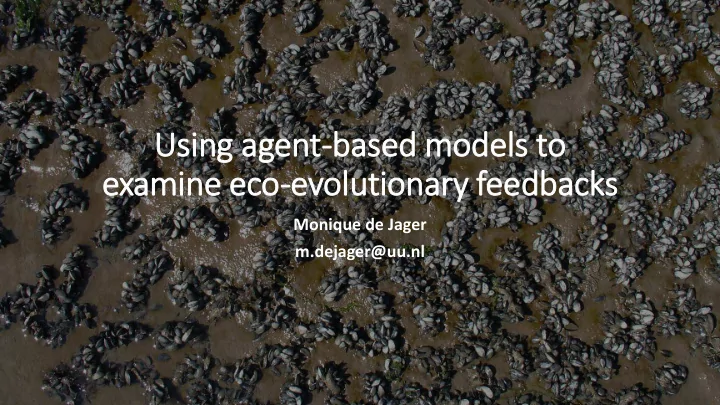

Us Using a g agen ent-bas ased ed model els t to exam amine e e eco-evol olution onar ary f y feedbac acks Monique de Jager m.dejager@uu.nl
PhD at NIOZ Yerseke I’m an evolutionary ecologist… With Johan van de Koppel Postdoc at UU With Merel Soons Postdoc at ETH Zürich With Jonathan Levine Mussel movement & cooperation Seed dispersal via water Seed dispersal & facilitation
PhD at NIOZ Yerseke I’m an evolutionary ecologist… With Johan van de Koppel Postdoc at UU With Merel Soons Postdoc at ETH Zurich With Jonathan Levine Mussel movement & cooperation Seed dispersal via water Seed dispersal & facilitation
My 3-year old: ‘WHY??’ ( ) It’s just a phase, it’s just a phase, it’s just a phase, it’s just a phase, it’s just a phase, it’s just a phase, it’s a monster, it’s just a phase, it’s just a phase, it’s just a phase, it’s just a phase I never left this phase…
Why do mussels aggregate? Why do individuals move? Why do individuals cooperate? Why do some plants limit their dispersal? Why facilitate other species? WHY?? Why do plants produce seeds of different sizes? Why move the way we move? Why do individuals behave the way they do? Why are some seeds buoyant and others not? Why do we find spatial patterns in nature?
Often, such questions are not easy to answer with a simple model… Evolution Fitness differences between individuals Traits / behaviour WHY?? of an individual Large-scale ecological processes Collective behaviour Eco-evolutionary feedbacks!
Often, such questions are not easy to answer with a simple model… Evolution Fitness differences between individuals Traits / behaviour WHY?? of an individual Large-scale ecological processes Collective behaviour Agent-based modelling Eco-evolutionary feedbacks! combined with adaptive dynamics
Why do mussels aggregate? Why do individuals move? Why do individuals cooperate? Why do some plants limit their dispersal? Why facilitate other species? WHY?? Why do plants produce seeds of different sizes? Why move the way we move? Why do individuals behave the way they do? Why are some seeds buoyant and others not? Agent-based modelling Eco-evolutionary feedbacks! combined with adaptive dynamics
Search strategies Directed search Random search + Information about target location -
Random searches in 2D Random displacements & reorientation events Step lengths and turning angles are drawn from frequency distributions Angle β
Random search strategies Step lengths and turning angles are drawn from frequency distributions Brownian walk
Brownian walk in 1D Equal chance to go right or left and chance to stay:
Brownian walk in 1D Equal chance to go right or left and chance to stay:
Brownian walk in 1D Equal chance to go right or left and chance to stay:
Brownian walk in 1D Equal chance to go right or left and chance to stay:
Brownian walk in 1D
Brownian walk in 2D
Random search strategies Brownian walk ( μ ≥ 3) Levy walk (1 < μ < 3) F(l) = C · l - μ
Viswanathan et al. (1996): Wandering albatrosses do a Levy walk! However: duration of dry period of wet/dry recording devices used as measurement…
Sims et al . (2008): Marine predators do a Levy walk!
De Jager et al. (2011, 2012, 2014): Mussels also do Levy walks!
Empirical data versus theoretical models! Empirical studies: Theoretical models: Levy walks are only optimal when: - Resources are limited, Levy walks abundant in nature - Indestructible, - Patchily distributed, - At unknown locations
Empirical data versus theoretical models! Empirical studies: Theoretical models: Levy walks are only optimal when: - Resources are limited, Levy walks abundant in nature - Indestructible, - Patchily distributed, WHY? - At unknown locations
Empirical data versus theoretical models! Nature: Theoretical models: Animals respond to AND Animals merely respond shape the environment! to their environment
Empirical data versus theoretical models! Nature: Theoretical models: Animals respond to AND Animals merely respond shape the environment! to their environment (Searching for conspecifics, redistribution of items, consumption, …)
Simple models do not consider eco-evolutionary feedbacks… Evolution Fitness differences between individuals Traits / behaviour Levy walks? of an individual Large-scale ecological processes Collective behaviour Agent-based modelling Eco-evolutionary feedbacks! combined with adaptive dynamics
De Jager et al. (2011, 2012, 2014): Mussels also do Levy walks!
Food Competition Cooperation
Building an agent-based model of mussel movement into patterned mussel beds… Move around, until local density is sufficiently high (dislodgement risk) and long-range density is low enough (food competition) How much movement is needed before a pattern is achieved? Simulate for: Straight-line dispersal ( μ → 1) Levy walk (1 < μ < 3) Brownian walk ( μ ≥ 3)
Levy walks are most efficient in creating patterned mussel beds Brownian Ballistic Lévy
Levy walks are most efficient in creating patterned mussel beds Brownian Ballistic Lévy But is it evolutionarily stable?
Levy walks are most efficient in creating patterned mussel beds Brownian Ballistic Lévy But is it evolutionarily stable? Compare efficiency of few mutants (with a different movement strategy) to efficiency of residents…
Levy walk with μ ≈ 2 is evolutionarily stable
Feedback between traits/behaviour & environment is important! Evolution Fitness differences between individuals Traits / behaviour of an individual Large-scale ecological processes Collective behaviour Evolutionary ecology: a complex system study!
Thanks for your attention Thanks to: Simon Benhamou Johan van de Koppel Guy Theraulaz Peter Herman Jos van Soelen Franjo Weissing Aniek van den Berg Bart Nolet Brian Silliman Max Rietkerk Andrea Kolzsch Sonia Kefi Fred Bartumeus For more information: M.deJager@uu.nl
After the break (10 minutes): A practical example of how to make an individual-based model using netlogo!
Recommend
More recommend